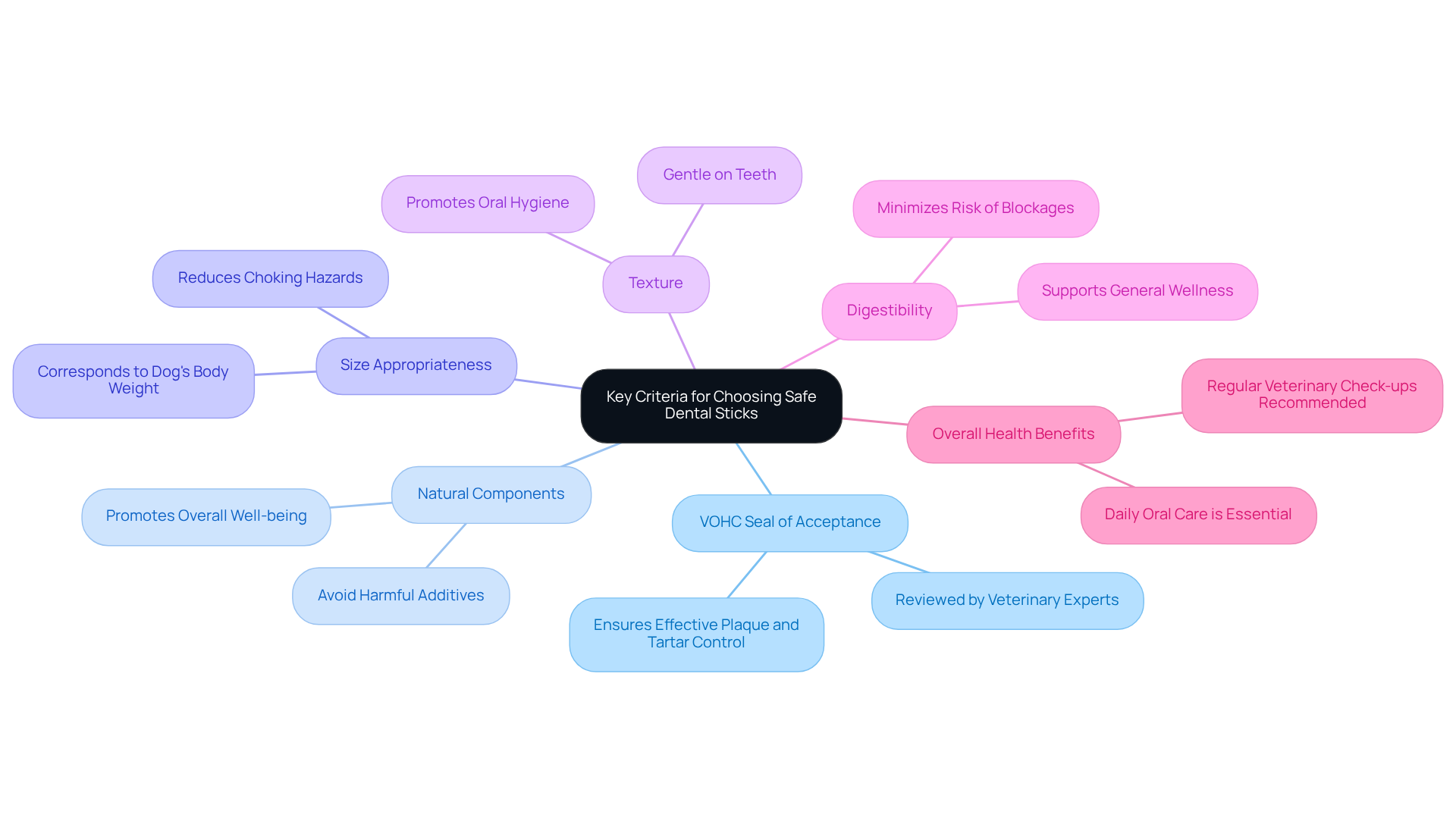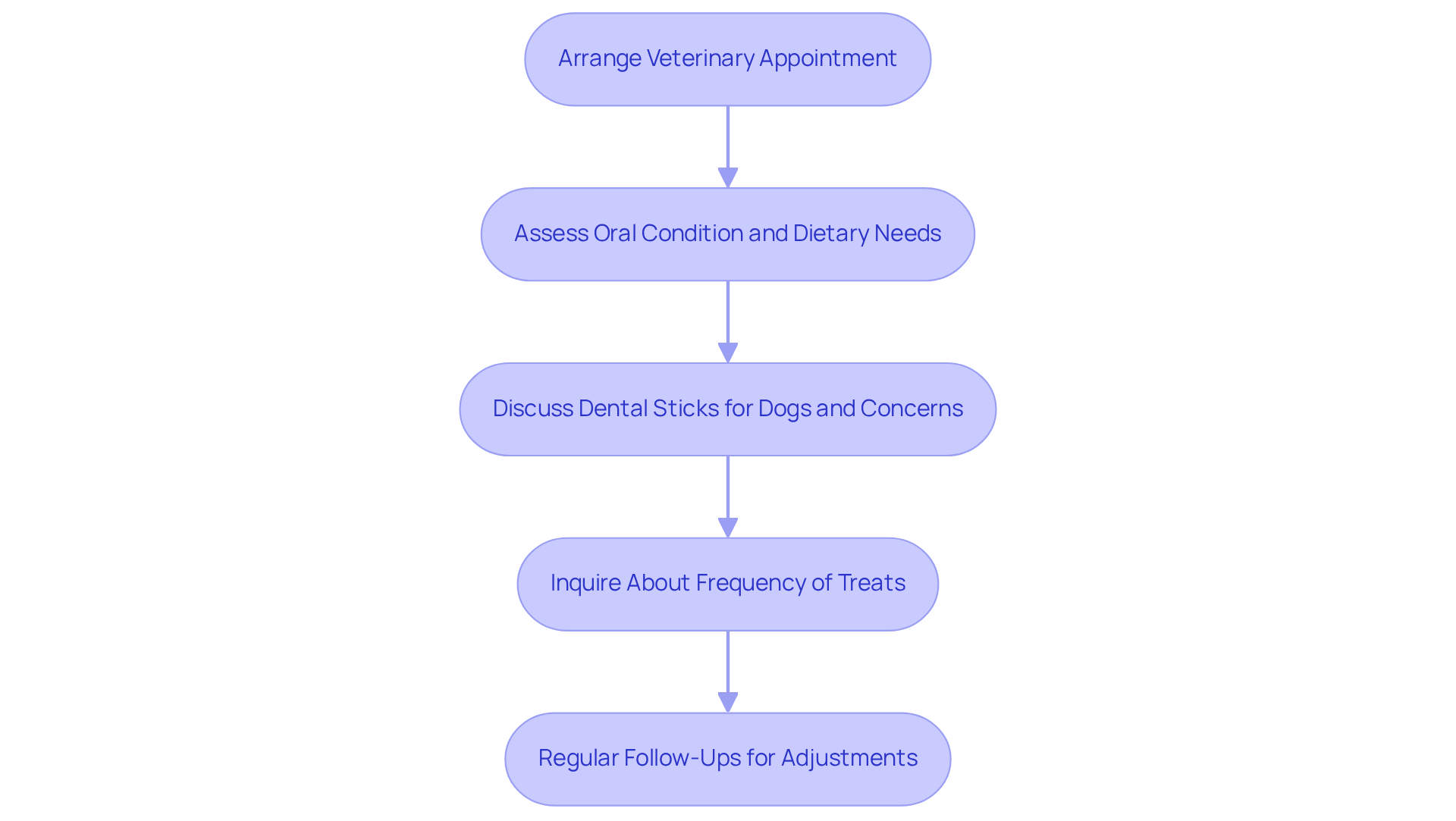Essential Checklist for Choosing Safe Dental Sticks for Dogs
Overview
When it comes to choosing safe dental sticks for your furry family members, it’s essential to focus on key criteria that ensure their well-being. Look for products that proudly display the Veterinary Oral Health Council (VOHC) Seal of Acceptance. Opt for those made with natural ingredients, and ensure the size and texture are just right for safe chewing. These factors play a crucial role in promoting oral health and preventing serious dental issues, ultimately enhancing the overall happiness and health of your beloved pets. By making informed choices, you are nurturing a caring environment for your dogs, helping them thrive.
Introduction
Caring for your furry family members’ dental health is not merely a luxury; it is a vital necessity that can profoundly influence their overall well-being. Did you know that over 80% of dogs aged three and older face oral health challenges? As a devoted pet owner, navigating the vast array of dental products available can feel overwhelming, but it is essential to ensure your beloved companions receive the best care possible.
With so many options on the market, how can you determine which dental sticks are truly safe and beneficial? This article provides a comprehensive checklist designed to guide you in selecting the right dental sticks, helping your pets enjoy delicious treats while reaping the health benefits of proper oral hygiene.
Understand the Importance of Dental Health for Dogs
Maintaining good oral health for your furry family members is crucial, as poor oral hygiene can lead to serious conditions such as heart problems, kidney issues, and systemic infections. Research indicates that over 80% of dogs older than three years face active oral health challenges, underscoring the importance of proactive oral care. As Courtney Barnes wisely notes, “Dental issues are among the most prevalent medical conditions encountered by veterinarians.”
Consistent oral care is vital for preventing plaque buildup and gum issues, which can escalate into more severe health concerns if neglected. The Royal Veterinary College highlights that daily tooth brushing is considered the gold standard for at-home oral care in dogs, ensuring they remain healthy and happy.
Your dog’s quality of life is significantly influenced by their oral health; discomfort from dental issues can hinder their ability to eat and play comfortably. While many pet owners recognize the importance of a nutritious diet for good oral health, perceptions of what constitutes a ‘nutritious diet’ can vary widely.
Regular oral examinations are essential for the early detection of dental problems, allowing for timely intervention and care. Routine professional check-ups are recommended to uncover and address oral issues, including malocclusions and tooth fractures.
Be vigilant for signs of oral health concerns, such as persistent bad breath, swollen gums, and difficulty eating, as these may indicate underlying health issues that need veterinary attention. Additionally, many dog owners face challenges like financial constraints and a lack of knowledge, which can hinder their ability to maintain proper oral hygiene for their beloved pets.

Identify Key Criteria for Choosing Safe Dental Sticks
- Prioritize chew sticks that bear the Veterinary Oral Health Council (VOHC) Seal of Acceptance. This seal signifies that these products meet rigorous standards for effective plaque and tartar control, ensuring that your furry family members receive the best care possible. The VOHC’s mission is to review products to guarantee their effectiveness when used as directed, giving you peace of mind.
- Choose items crafted from natural components, steering clear of harmful additives like synthetic preservatives and fillers. These can adversely affect your dog’s well-being. Remember, daily oral care is the gold standard for maintaining excellent oral health, making the choice of hygiene sticks crucial for your pet’s happiness.
- Select chew sticks that are appropriately sized for your dog’s breed and chewing behaviors. This helps reduce choking hazards and ensures safe ingestion. It’s important for pet owners to provide chew sticks that correspond to their dog’s body weight, promoting a safe and enjoyable experience.
- Look for a texture that effectively promotes oral hygiene while being gentle enough to prevent damage to your dog’s teeth. Regular use of VOHC-approved products can significantly reduce the severity of periodontal disease, making it essential to incorporate them into your dog’s daily routine for their overall health.
- Ensure that the chew sticks are made from premium, digestible substances to support your pet’s general wellness and welfare. Regular veterinary check-ups of the mouth and teeth are advised to ensure optimal oral condition, particularly for middle-aged and senior pets.
- By including these chew sticks in your pet’s routine, you can assist in preserving their oral health and minimizing the likelihood of blockages during chewing activities. Your commitment to their care makes all the difference.

Recognize Treats to Avoid for Your Dog’s Safety
As a loving pet owner, it’s essential to be mindful of the snacks you choose, such as dental sticks for dogs, for your furry family members. Tough snacks like antlers, bones, and certain rawhides can break a dog’s teeth, leading to painful oral problems. Dr. Mary Buelow emphasizes that many popular chews can cause severe oral injuries in our beloved canines.
Additionally, it’s wise to steer clear of dental sticks for dogs that contain synthetic flavors, colors, or preservatives, as these can pose health hazards for your pet. Opting for treats without high-fat content is crucial, as these can contribute to pancreatitis, a serious condition in dogs.
Be cautious with treats made in countries with less stringent safety regulations, as they might not meet the quality standards we want for our pets. Furthermore, eliminating any treats that contain known allergens, such as wheat or soy, is vital to prevent allergic reactions and digestive issues.
Lastly, always watch for signs of oral problems, like reluctance to chew, dropping food, or decreased activity levels. These could indicate underlying issues related to the treats your dog consumes. By staying informed and proactive, you can create a nurturing environment for your beloved pet.

Consult Your Veterinarian for Personalized Recommendations
Arrange a veterinary appointment to assess your furry family member’s oral condition and dietary needs. By age 3, an alarming 70% of pets may show early signs of periodontal disease, making this step crucial for their health.
Consult your veterinarian for suggestions on dental sticks for dogs that are appropriate for your dog’s age, breed, and medical condition. Look for dental sticks for dogs that proudly display the Veterinary Oral Health Council (VOHC) seal of acceptance, ensuring their effectiveness in maintaining your pet’s oral health.
Discuss any specific oral health concerns your dog may have, as these can significantly influence the choice of treats. Remember, unresolved oral issues can lead to serious medical problems, including heart disease, which can impact your beloved companion’s quality of life.
Inquire about the recommended frequency for providing oral treats, considering your dog’s overall diet and health condition. Regular follow-ups with your veterinarian are essential in adjusting your dog’s oral care plan as needed, ensuring they remain happy and healthy.
As a veterinarian wisely noted, “Periodontal disease is the most common dental condition in dogs and cats,” underscoring the importance of regular checkups to keep your pet thriving.

Conclusion
Ensuring the oral health of your furry family members is a fundamental aspect of responsible pet ownership. By understanding the critical role dental care plays in a dog’s overall well-being, you can take proactive measures to prevent serious health issues stemming from poor oral hygiene. Prioritizing dental health not only enhances the quality of life for your pets but also fosters a deeper bond between you and your beloved companions through shared care and attention.
This article delves into key criteria for selecting safe dental sticks, emphasizing the importance of products that bear the Veterinary Oral Health Council (VOHC) Seal of Acceptance. It highlights the need for:
- Natural ingredients
- Appropriate sizing
- Textures that promote oral hygiene without causing harm
Additionally, it advises against certain harmful treats and stresses the significance of regular veterinary consultations for tailored recommendations. Each point reinforces the idea that informed choices lead to healthier, happier pets.
In conclusion, your commitment to maintaining your dog’s dental health is a vital investment in their long-term happiness and vitality. By choosing safe dental sticks and avoiding harmful treats, you can make a significant difference in your furry companions’ lives. Embracing these practices not only protects against dental diseases but also encourages a proactive approach to overall pet care. Prioritize your dog’s oral health today, and consult your veterinarian for personalized advice to ensure a brighter, healthier future for your cherished pet.
Frequently Asked Questions
Why is dental health important for dogs?
Dental health is crucial for dogs because poor oral hygiene can lead to serious conditions such as heart problems, kidney issues, and systemic infections.
What percentage of dogs older than three years face oral health challenges?
Research indicates that over 80% of dogs older than three years face active oral health challenges.
What is the gold standard for at-home oral care in dogs?
Daily tooth brushing is considered the gold standard for at-home oral care in dogs.
How does a dog’s oral health affect their quality of life?
A dog’s oral health significantly influences their quality of life, as discomfort from dental issues can hinder their ability to eat and play comfortably.
What are some signs of oral health concerns in dogs?
Signs of oral health concerns include persistent bad breath, swollen gums, and difficulty eating.
Why are regular oral examinations important for dogs?
Regular oral examinations are essential for the early detection of dental problems, allowing for timely intervention and care.
What challenges do dog owners face in maintaining their pet’s oral hygiene?
Many dog owners face challenges such as financial constraints and a lack of knowledge, which can hinder their ability to maintain proper oral hygiene for their pets.







